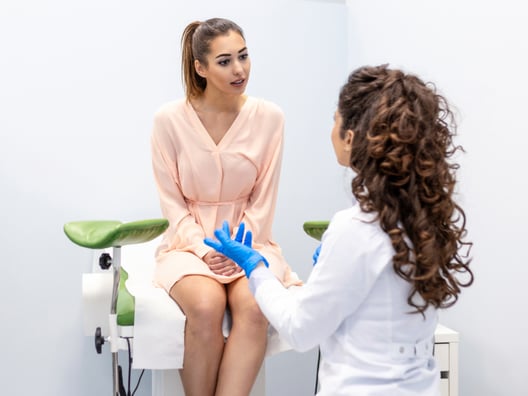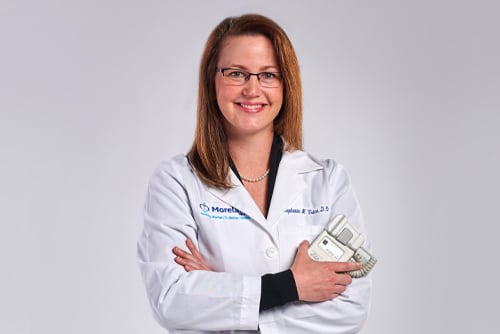 Many women may face the discomfort of a vaginal infection at some point in their lives. Yeast infections, bacterial vaginosis (BV), and trichomoniasis are three common vaginal infections that can lead to itching, burning, unusual discharge, and vaginal odor.
Many women may face the discomfort of a vaginal infection at some point in their lives. Yeast infections, bacterial vaginosis (BV), and trichomoniasis are three common vaginal infections that can lead to itching, burning, unusual discharge, and vaginal odor.
Below, we guide you through each of these common vaginal infections, helping you understand their causes, symptoms, and treatment options.
Keep reading to learn more!
Yeast Infections
A vaginal yeast infection is a fungal infection that results in irritation, discharge, and itchiness of the vagina and vulva. Also known as vaginal candidiasis, yeast infections are caused by an overgrowth of a fungus called Candida albicans. Yeast infections are very common and impact up to 75% of women at some point in their life, with many women experiencing at least two in their lifetime.
Causes of Yeast Infections
While yeast infections are not considered sexually transmitted infections (STIs), there is an increased risk of getting a yeast infection when you first become sexually active. There has also been a link between oral sex and yeast infections. The introduction of new bacteria and hormonal changes can also disrupt the vagina’s delicate pH balance and encourage yeast overgrowth.
The overgrowth of yeast can be a result of several factors, such as:
- Antibiotics — Antibiotic medications can disrupt the balance of microorganisms in the vagina and unintentionally eliminate the good bacteria that help maintain a healthy vaginal environment.
- Pregnancy — The hormonal shifts that occur during pregnancy can affect the balance of vaginal yeast and bacteria. For example, increased levels of estrogen create favorable conditions for Candida albicans.
- Uncontrolled diabetes — Candida thrives on sugar, and the high blood sugar levels associated with uncontrolled diabetes provide a favorable environment for yeast infections.
- Impaired immune system — A weakened immune system decreases the body’s ability to control the growth of Candida effectively.
- Oral contraceptives or hormone therapy — Birth control and hormone therapies can increase estrogen in the body, contributing to conditions conducive to yeast infections.
Yeast Infection Symptoms
There are several symptoms associated with vaginal yeast infections. Symptoms can range from mild to moderate and typically include:
- Itching and irritation in the vagina and vulva area
- A burning sensation during intercourse or urination
- Redness and swelling of the vulva
- Vaginal rash, pain, and soreness
- Thick, white, odorless vaginal discharge that resembles the appearance of cottage cheese
- Watery vaginal discharge
Reducing Your Risk of Yeast Infections
There are different actions you can take to reduce the risk of vaginal yeast infections:
- Wear underwear made of breathable fabric like cotton.
- Avoid tight-fitting pants and pantyhose, as they can lead to a warm and moist environment that allows yeast overgrowth.
- Avoid douching, which removes the healthy bacteria that protect you from infection.
- Don’t use scented products like bubble baths, pads, and tampons, which can all disrupt the vaginal PH balance.
- Avoid unnecessary antibiotic use.
- Don’t sit in wet clothes such as swimsuits and workout gear for extended periods.
Treatment Options
If you have had a yeast infection and are experiencing similar symptoms, over-the-counter antifungal creams may help clear the infection. Although, you should make an appointment with your doctor if:
- This is the first time you have experienced yeast infection symptoms.
- You’re unsure if you have a yeast infection.
- Over-the-counter antifungal creams or suppositories aren’t helping your symptoms.
- Other symptoms develop.
Bacterial Vaginosis (BV)
 A healthy vagina has more “good” bacteria (lactobacilli) than “bad” bacteria (anaerobes). Bacterial vaginosis (BV) occurs when the “bad” bacteria take over. While BV can occur at any age, it most commonly occurs during the reproductive years due to hormone changes that allow certain bacteria to grow.
A healthy vagina has more “good” bacteria (lactobacilli) than “bad” bacteria (anaerobes). Bacterial vaginosis (BV) occurs when the “bad” bacteria take over. While BV can occur at any age, it most commonly occurs during the reproductive years due to hormone changes that allow certain bacteria to grow.
Causes of BV
While the exact cause of BV is not fully understood, risk factors include:
- Sexual activity — Different or new sex partners are commonly linked to BV. Bacterial vaginosis is also more common among female-to-female sexual activity.
- Douching — The chemicals in douches can upset the PH balance in the vagina, leading to an overgrowth of anaerobic bacteria. The vagina is self-cleaning, so douches are unnecessary, and they may do more harm than good.
Symptoms of BV
Symptoms of bacterial vaginosis include:
- Thin, vaginal discharge that can be gray, white, or green
- A foul-smelling “fishy” smell coming from the vagina
- Vaginal itching
- Burning during urination
- Some may experience no symptoms
Explore the types of vaginal odors that are normal and those that may be a sign of an issue.
Lower Your Risk of BV
Below are some preventative measures you can take to limit your risk of BV:
- Avoid scented products like soaps, pads, and tampons, which can upset the vaginal PH balance and lead to the overgrowth of “bad” bacteria.
- Never use a douche. Douching can upset the vaginal balance, leading to worsened symptoms. Wash your vulva with warm water or a mild fragrance-free soap designed for sensitive skin. You do not need to wash the inside of your vagina.
- Practice safe sex by using a form of barrier birth control, such as condoms. Make sure sex toys are always clean, and limit your number of sexual partners.
BV Treatment Options
You should make an appointment with a healthcare professional if:
- Your vaginal discharge smells and looks unusual.
- Your vaginal discharge seems normal but is accompanied with discomfort or itching.
- You have a new sexual partner.
- Your symptoms are not getting better
If your doctor confirms you have BV, they will prescribe an oral or vaginal antibiotic. Take your medicine or use the cream or gel for as long as prescribed, even if your symptoms disappear, to prevent BV from recurring.
Read this blog post for more tips on healthy hygiene practices for optimal vulva and vaginal health!
Trichomoniasis
Trichomoniasis is a sexually transmitted infection (STI) caused by a parasite that is passed during close sexual contact. The parasite infects the lower genital tract, which includes the vulva, vagina, cervix, and urethra. Symptoms can develop anywhere from four to twenty-eight days after exposure.
Trichomoniasis Symptoms
Many individuals who develop trichomoniasis show no signs or symptoms. Women who develop symptoms may experience:
- Excessive discharge that is thin and has a foul odor. The discharge may be clear, white, gray, yellow, or green and can have a foamy texture.
- Genital redness, burning, and itching.
- Pain during sex or urination.
- Discomfort in the lower stomach.
Trichomoniasis Prevention and Treatment
Like any sexually transmitted infection, the best way to significantly lower your risk of trichomoniasis is to practice safe sex. Practicing safe sex means you should always use a condom. If you show any symptoms of trichomoniasis or become aware a sexual partner has the infection, see your healthcare provider to be prescribed antibiotics.
Your partner(s) should also get treated, and your doctor may give you a separate dose of antibiotics for your partner. When treating trichomoniasis, the medication prescribed usually is only one dose. Do not have sex for a week after you finish the antibiotics to avoid the risk of being reinfected.
At Moreland OB-GYN, we create a safe environment where you are encouraged to ask questions about your vaginal and vulva health. Learn what you can expect during your exam in this blog post.
Similar Symptoms, Different Infections
Although yeast infections, BV, and trichomoniasis each have distinct symptoms, they also share many common ones, making it hard to self-diagnose. If you experience any symptoms that may indicate an infection, it’s important to make an appointment with your doctor so they can prescribe the correct treatment course.
Trying to self-treat with the wrong over-the-counter medicine may make the infection and symptoms worse. Your doctor can also help you avoid future infections by determining if there is an underlying cause like undiagnosed diabetes or hormone imbalances.
Are you experiencing uncomfortable vulva and vaginal symptoms? Your Moreland OB-GYN doctor can help diagnose the issue and offer proper treatment options. Contact us today to schedule an appointment.
Is It a Vaginal Infection or Something Else?

It’s important to note that some vaginal or vulva skin disorders may present symptoms similar to yeast infections, bacterial vaginosis (BV), or trichomoniasis.
These skin disorders include:
- Folliculitis: Small, red, and sometimes painful bumps caused by bacteria in an infected hair molecule. Often a result of shaving, waxing, or friction. The bumps often go away on their own, but paying extra attention to hygiene and wearing loose clothing can help speed up the healing process.
- Contact dermatitis: Severe itching, rawness, stinging, and burning. Contact dermatitis is caused by skin irritation from soaps, fabrics, and perfumes. Ice packs can reduce irritation, and a thin layer of petroleum jelly can be applied over the skin for protection. Treatment includes eliminating the source of irritation. A topical steroid cream or ointment may be needed for more severe cases.
- Bartholin gland cysts: Cysts form near the vaginal opening when Bartholin glands become blocked. The cysts are usually painless unless infected, which can lead to an abscess. If you are not experiencing pain, the cyst can be treated at home by sitting in a warm, shallow bath or using a warm compress. If an abscess has formed, your doctor will drain the abscess to treat it.
- Lichen simplex chronicus: Thickened, scaly “plaques” form on the vulva, causing severe itching. It may result from contact dermatitis or another skin disorder that has been present for a long time. Treatment includes refraining from the “itch-scratch” cycle to allow the skin to heal. Steroid creams and treatment of an underlying skin issue may also be needed.
- Lichen sclerosus: Leads to itching, burning, and pain during sex. Tears in the skin may develop, and the vulva may appear thin, white, and crinkled. White bumps with a dark purple color may also form. Treatment includes a steroid cream or ointment.
- Lichen planus: Itching, soreness, and burning of the vulva and vagina. Abnormal discharge may occur. The appearance of lichen planus can vary between white streaks on the vulva, the entire vaginal surface, or dark pink bumps. It can be treated with medicated creams, vaginal tablets, pills, or injections.
These skin disorders, such as lichen sclerosus and contact dermatitis, can also affect children. If you or your child are encountering itching or burning in the vulva area for the first time, it's best to schedule a visit with your doctor to get an accurate diagnosis and treatment plan.
Learn about our pediatric gynecology services here.
Why Choose Moreland OB-GYN?
 No one wants a vaginal infection, but they are sometimes unavoidable. If you’re experiencing any symptoms, such as vaginal itching, burning, unusual discharge, swelling, or an unusual appearance of the vaginal area, don't hesitate to schedule an appointment with Moreland OB-GYN.
No one wants a vaginal infection, but they are sometimes unavoidable. If you’re experiencing any symptoms, such as vaginal itching, burning, unusual discharge, swelling, or an unusual appearance of the vaginal area, don't hesitate to schedule an appointment with Moreland OB-GYN.
Our dedicated team of providers is here to help address your concerns and provide the treatment and care you need to prioritize your health. We take pride in serving women at our seven locations across southeastern Wisconsin.
At Moreland OB-GYN, we are committed to delivering compassionate care to all patients. We believe in shared decision-making and strive to create an exceptional patient experience for everyone we serve.









